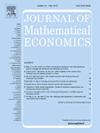Bargaining-Equilibrium等价
IF 0.7
4区 经济学
Q3 ECONOMICS
引用次数: 0
摘要
本文试图通过研究俱乐部经济的俱乐部均衡分配集与议价集之间的等价性,来回答一般均衡理论中较为新生的问题之一。在这个框架中,俱乐部与私人物品一样被视为可选择的物品。每个扶轮社由两部分组成:(i)扶轮社简介及(ii)扶轮社计划。我们定义了一个两步否决机制,并引入了与Aumann et al.(1961)一致的讨价还价集。在本文中,我们建立了非俱乐部均衡分配是指存在一组代理人和一个价格向量,在这个价格向量上,他们同意在他们之间进行交易,而不是消耗分配给他们的非俱乐部均衡分配,并且所有其他代理人(弱)更倾向于在该特定价格向量上进行交易。换句话说,瓦尔拉斯式反对任何非俱乐部均衡分配。我们进一步证明了瓦尔拉斯式的反对意见也是合理的,这有助于我们建立均衡分配集与无原子俱乐部经济的议价集之间的等价关系。本文章由计算机程序翻译,如有差异,请以英文原文为准。
Bargaining-Equilibrium equivalence
The paper tries to answer one of the more nascent questions in the literature on general equilibrium theory by investigating the equivalence between the set of club equilibrium allocations and the bargaining set for a club economy. Clubs in this framework are treated in a parallel fashion to private goods as articles of choice. Each club comprises two components: (i) the profile of the club and (ii) the club project. We define a two-step veto mechanism and introduce the bargaining set in line with Aumann et al. (1961) for such an economy. In this paper, we establish that non-club-equilibrium allocations are those against which there exists a set of agents and a price vector at which they agree to trade amongst themselves rather than consume the non-club-equilibrium allocation assigned to them and all other agents (weakly) prefer the non-club-equilibrium allocation to trading at that particular price vector. In other words, there is a Walrasian objection to any non-club equilibrium allocation. We further show that Walrasian objections are also justified, which helps us to establish our equivalence between the set of equilibrium allocations and the bargaining set for an atomless club economy.
求助全文
通过发布文献求助,成功后即可免费获取论文全文。
去求助
来源期刊

Journal of Mathematical Economics
管理科学-数学跨学科应用
CiteScore
1.70
自引率
7.70%
发文量
73
审稿时长
12.5 weeks
期刊介绍:
The primary objective of the Journal is to provide a forum for work in economic theory which expresses economic ideas using formal mathematical reasoning. For work to add to this primary objective, it is not sufficient that the mathematical reasoning be new and correct. The work must have real economic content. The economic ideas must be interesting and important. These ideas may pertain to any field of economics or any school of economic thought.
 求助内容:
求助内容: 应助结果提醒方式:
应助结果提醒方式:


